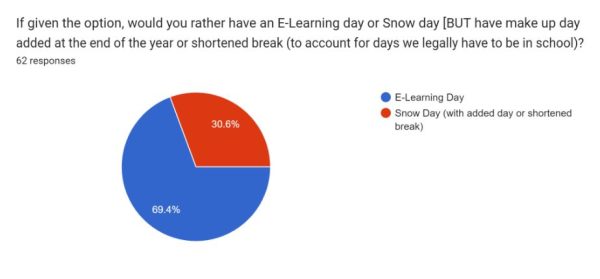
Anticipating, hoping, and praying the weather is perfect for the words Snow Day to be in their future. For years kids have been getting up early to check the news, their email, or wait for a phone call in hopes of getting the good news. But have Snow Days taken a turn for the worse? From fun days in the snow to sitting behind a computer screen, snow days have had drastic changes, but whether these changes are causing more harm than benefit is the question.
To avoid adding more days onto the summer or shortening breaks, schools have resorted to remote learning. E-learning days allow “students to remain connected with an educator” (cbsnews.com). Many schools use E-Learning days to prevent students from falling behind and continuing education. However, student Sapphire Bankston-Hunter, a senior at Woodlands Academy, disagrees. According to Bankston-Hunter, “My camera and microphone often don’t work and it makes it difficult to engage in my class. I can barely participate.” E-learning has made it difficult for students to fully connect in class.
This brings the quality of education for that day of school into question. Junior Maeve Driscoll says, “The temptation to turn off the camera and not participate when you aren’t in the classroom is hard too. I’m in my room with a lot of distractions and it’s very hard to learn through a screen.” School days are for learning and it’s possible remote learning is not doing a school day justice.
Especially for younger children who just want to have fun. If it’s difficult for high school students to stay off distractions, imagine what it could be like for those kids. According to the Columbia Tribune, “A snow day gives kids the chance to do what kids have naturally done for thousands of years — be kids” (colombiatribune.com). It can be difficult to have younger children, who need more care and attention, sit behind a screen and focus. Offering a “mental health break” the Columbia Tribune continues to mention that “some children struggle with a break in their routine.” So the unexpected snow day “helps them learn to adjust to changes and make the most of unexpected situations.” Forcing them to stay behind a screen prevents them from exploring their creativity and having fun. But maybe there is an upside.
E-Learning does present an opportunity for school days not to have to be made up. Legally a school has to have a specific number of days when they are in class. Often the number is 180 required days. Having that remote learning allows the school to not have to make up days. Students at Woodlands Academy were asked their preference for having an E-Learning vs Snow day with added days and here were the results:

The survey contained 62 responses with 69.4% of those students preferring an E-Learning day over the 30.6% of students who prefer a snow day. But why? According to junior Lauren Janos, “An e-learning day allows us to just get a day of school over with. I don’t want extra days cutting into the summer or having shortened breaks” Understandably, this opinion is shared among students who don’t want more school. But when the quality of that schooling is less than days in person the question becomes is it worth it? Especially after the recent pandemic, maybe it’s a smart move for schools to be straying away from online learning.
According to Education Week, many children during the COVID-19 pandemic, “barely logged on, and many struggled with the social isolation.” This poor quality of education linked with online education was marked by “widespread learning losses” (smith.edu). With the already big impact the pandemic made on children, e-learning days might continue those same negative impacts. Although compared to the pandemic lasting months online, e-learning only happens a few days out of the year.














